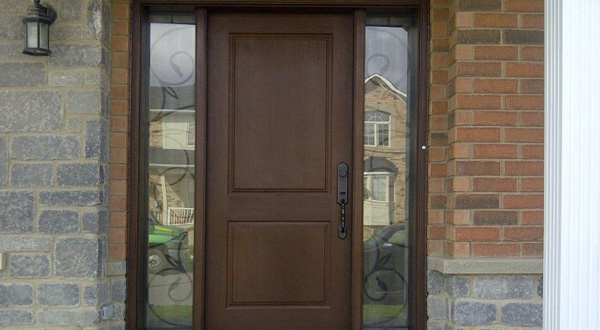The entry door, sometimes referred to as exterior or front doors, is the line of separation between your personal space and the outside world. It’s where your inner universe meets the outside world face-to-face. Transitioning from one point to another is a vital moment, and so it’s important for the entrance door to represent and satisfy all that’s needed for the transition. These worries include aesthetics, safety, energy-efficiency, climate resistance and much more. In this article, we are going to have a thorough look at entry doors; the various types, and the features that should be considered when choosing one.
The Different Types of Entry Doors
When it comes to exterior doors, you generally find three types of materials: wood, steel and fibreglass. A new modern ‘Glass Panel’ Entry Door’ with a full view is also becoming increasing popular. These 4 account for most of the entry door sales. Let’s take a look.
Wood Entry Doors
Wood remains a favourite material to build exterior doors due in large part to its incredible beauty and design versatility. Furthermore, its unparalleled tactile qualities can’t be beat by any other material. Wood is a timeless material, and people have been using it to make doors since the beginning of civilization. This gives wood an undeniable advantage over other materials. Wooden doors are part of our cultural heritage and have been used by almost everyone. Wood is something that has been around for centuries and its presence in our lives is profound. Consequently, wooden doors make up an integral component of our cultural DNA.
Although wooden doors offer a variety of advantages, they can also bring some drawbacks along with them. One of the primary drawbacks of using wood is that it can rot, warp and split easily due to being a natural material. Wooden entry doors, however, also have some potential downsides that one should be aware of. Mold and termites love this kind of environment as the conditions are perfect for their growth. This makes them the primary beneficiaries of such areas where proper sanitation is neglected.
Nevertheless, wooden doors remain a viable option! Crafting and treating processes for wood exterior doors have advanced significantly recently, allowing them to perform a lot better in terms of defeating humidity as well as preventing pests from entering. Wood doors are still popular today, but they need to be maintained regularly. Additionally, anything made of natural materials in the future will inevitably cost more than artificial products. Sometimes significantly more than other materials. So, to sum up the pros and cons of wooden entry doors:
Pros
- The Human Love Affair with Wood is Still Strong
- Inheriant asthetic effects
- Numourous Design Choices
- Easily painted or stained to match changing aesthetic needs
Cons
- Fairly high maintenance
- Tend to crack and rot
- Can attract molds and pests
- Expensive
Steel Entry Doors
Steel doors have gained plenty of market share in recent years and for a number of good reasons. Steel entry doors are heavy, strong and secure. They won’t rot or warp. They won’t swell or shrink and if they dry out they’re not going to develop long, destructive cracks. Steel panel exterior doors are typically well insulated and much more effective than wooden doors when it comes to preventing heat transfer. Steel doors also have come a long way in recent years when it comes to design possibilities and they’re often cheaper than wooden doors. Indeed it’s sometimes difficult to tell nowadays whether a door is steel or wood. So why doesn’t everyone, everywhere have a steel door on their home?
In spite of the fact that there are some distinct advantages to steel entry doors there are also a couple of good reasons they are not (yet anyway) the industry standard. To begin with they won’t rot but they are prone to corrosion should their surface be left exposed to the elements. This is especially true in areas of high humidity. On top of that a steel door can be dented if struck with a hard object, or even a not so hard object (like a ball) moving at sufficient speed. And once dented they can be devilishly difficult to flatten out again. Steel doors are also prone to scratching and once a scratch takes hold it can lead to rust which quickly spreads beyond the confines of the scratch. So to sum up the pros and cons of steel doors:
Pros
- Typically not as expensive as wood
- Provide first class insulation
- Provide a high level of security
- Ever improving designs
Cons
- They’re prone to denting and scratching
- Scratches can quickly begin to rust and look unsightly
- They’re can be high maintenance
- They can be difficult to repair
Fibreglass Entry Doors
Fibreglass doors offer an attractive and budget-friendly solution compared to both wooden and steel doors. They are exceptionally durable, have a long lifespan, and provide similar design options as wood. Steel doors provide unbeatable advantages including aesthetic appeal, insulation, and energy efficiency. And unlike both wood and steel they won’t ever rot, rust or otherwise corrode. Fibreglass is really versatile and can be molded into any shape imaginable – from the look of luxurious hardwood to metallic steel plating. This gives fibreglass doors the ability to meld seamlessly with any design aesthetic from Colonial to Victorian to Mid-Century Modern and Postmodern. And to top it all off they’ll normally cost less than a wooden door and not much more than a typical steel door.
Although highly advantageous, fibreglass doors are not without their flaws. It’s important to be aware of any potential cons when making a decision about which type of door to choose. Fortunately for those considering this type of door for their home those cons are few in number. Poor maintenance of a door can make it brittle and vulnerable over time, leading to potentially serious problems if not addressed in a timely manner. Taking good care of your door is quite simple as it does not require a great deal of effort. It just involves routinely inspecting the lacquer and re-coating the door every few years if necessary. So to sum up the pros and cons of fibreglass entry doors:
Pros
- High weather resistance/insulation
- Extreme aesthetic versatility-key to obtaining a distinct look
- Won’t rot, rust, crack or corrode
- Very little maintenance required
- Less expensive than wood
Cons
- Poor maintenance may lead to the door becoming brittle
Glass Entry Doors
It goes without saying that glass entry doors let the most light into your home and the ambiance created is easing and relaxing. Glass entry doors are often the best choice for commercial settings but more homeowners are choosing glass entry doors for their modern look and style. The curb appeal created is stunning and eye-catching to say the least. Glass entry doors are still very safe and energy efficient and function as well or even better than a standard door. A beautiful glass entry door can also perfectly blend with your home’s style and other doors and windows creative a very visually appealing effect. It should be a strong consideration if you are looking to complete a dramatic and modern new home look. Evolve specializes in ‘Glass Entry Doors’ and can assist with everything from design, build and install. Get in touch today.
Pros
- If part of a design style can add stunning curb appeal
- High weather resistance/insulation benefits
- Easy maintenance
Cons
- Not a good choice for some home styles

